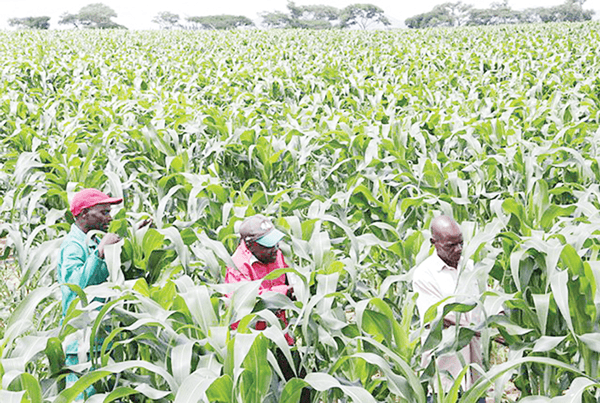
By Cliff Chiduku ACCORDING to a latest Food and Agriculture Organisation (FAO) analysis, Zimbabwe’s cereal production declined slightly below average to 1,6 million tonnes in 2022.
“Despite an above average planted area of 1,9 million hectares, the 2022 production of maize (the main food staple) is officially estimated at about 1,6 million tonnes, slightly below the five-year average and 45% down from the bumper harvest in 2021. The lower output predominantly reflects the impact of unfavourable rains on yields, coupled with the effects of high temperatures,” a FAO report released last Monday reads.
FAO says other cereal crop yields were similarly affected by the adverse weather conditions and the 2022 outputs of sorghum and millet are estimated to be around 40% below their averages.
The decline in domestic stocks, as well as the effects of high wheat prices and global supply chain disruptions due to COVID-19 and the Russia-Ukraine war, undoubtedly mean the food situation in the country will be dire. This means rice imports are foreseen to rise to above the five-year average levels, with international prices comparatively stable, FAO added.
To compensate for the lower cereal output, government last month announced plans to import 400 000 tonnes of maize from Zambia and Malawi.
The country has faced food insecurity since the turn of the century when the country embarked on the land reform programme. Zimbabwe has also endured frequent droughts over the past few years, with conditions expected to worsen due to climate change.
Agriculture is central to Zimbabwe’s hopes of reviving its ailing economy. Getting agriculture moving in Zimbabwe is a big task. The radical land reform of 2000 triggered many complex challenges; not least the importance of compensating former commercial farm owners. But the biggest challenge lies in the new land ownership regime. With all land now under government control, the new farmers are mere lodgers who cannot use the land they acquired as collateral because banks are not accepting the offer letters and 99-year leases they possess.
While today there are small, medium-sized and commercial farms, one would have thought that these increased numbers should translate to increased production. This has not been the case.
- Chamisa under fire over US$120K donation
- Mavhunga puts DeMbare into Chibuku quarterfinals
- Pension funds bet on Cabora Bassa oilfields
- Councils defy govt fire tender directive
Keep Reading
Zimbabwe’s arable land is relatively small compared to major food producers in Africa, but its agriculture performance from 1961 to 2001 was a cut above the rest with the country producing up to 10% of African maize output in 1985.
The excellent performance saw Zimbabwe being Africa’s biggest tobacco grower and the sixth largest in the world. Tobacco is Zimbabwe’s leading agricultural export and one of its main sources of foreign exchange, with 54% of the tobacco being sold to China in 2015.
The land reform programme, however, disrupted tobacco production with harvests falling by 79% between 2000 and 2008. Nonetheless, the industry recovered after the contract system was introduced in 2008. In 2014, Zimbabwe produced 217 million kg of tobacco, the third largest crop on record. But that entire crop was largely exported raw. We desperately need value-addition in agriculture to help shore up the economy.
Most of the newly-settled farmers also lack knowledge and basic agricultural training. The farmers also need to understand that farming is a business which must be taken seriously, which is why the billions of dollars which have so far been pumped into agriculture through such initiatives as the mechanisation programme have all come to naught.
Brilliant policies on paper have also all amounted to nothing because there was no full commitment to implementing the programmes.
This lack of commitment, especially by government, has resulted in such initiatives as land audits to weed out those failing to produce or those speculatively holding onto multiple farms, being nothing but hot air.
Zimbabwe needs to be serious about making its land productive and its economy will only start to grow once government and the people in general realise the importance of agriculture. Developed countries across the world all became industrialised economies by first transforming their agricultural sectors.
Agriculture contributes 16,2% of the gross domestic product in Africa and employs over 70% of the population. It holds the key to accelerated growth, diversification and job creation.
The government should support massive agro-industrial development. Once that happens, the country will be on course to repositioning itself as a global powerhouse in food production.
All the country’s agricultural research stations, and they were quite a number before, should be revived and linked to farmers so that their farming activities are well-informed rather than the current haphazard and ill-informed farming practices taking place.
Zimbabwe must not reinvent the wheel, but simply ride on already existing developments in agriculture, especially mechanisation and technological innovations that have arisen over the decades.
Israel, for example, has used technological innovations to improve its agriculture production despite the country being mostly desert.
Agronomists and plant scientists have made incredible progress in understanding what crops are in particular regions and nations are using this to strategically position their agricultural production to shore up their economies.
There is nothing stopping Zimbabwe from doing the same.
Take drip irrigation, for instance, it has become one of the most famous agricultural technologies across the world. It has proven to deliver the dual benefit of increased production and efficient use of water, fertiliser and herbicides.
It is embarrassing that Zimbabwe is now importing maize from Zambia and Malawi, yet the country used to export to these nations.
According to FAO, Zambian small-scale farmers produce 80% of their country’s food. Zambia has a farm subsidy programme — Farmer Input Support Programme (FISP). It has its flaws, but is evidently more efficient than our Presidential Input Scheme, which is corruption-ridden and inefficient. FISP reaches out to one million farmers per year.
The government should work on sustainable agriculture financing model. Leaving foreign multinationals to finance agriculture through contract farming is disastrous. The model is not sustainable. Contract farmers have been left at the mercy of uncaring international companies who ill-treat and exploit them and the government has done nothing to help the situation.
Unless compressive reforms are instituted, Zimbabwe will always be food insecure; it will continue to be a net food importer despite it having arable land.
Food for thought!
- Cliff Chiduku is a journalist based in Harare. He can be contacted on +263775716517, Email: [email protected] or on Twitter @ChifChiduku.











